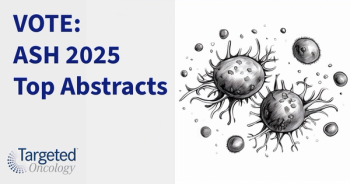
Cilta-cel Demonstrates Significant Advantage Over SOC in Triple-Class R/R Myeloma
A CARTITUDE-1 meta-analysis data shows that ciltacabtagene autoleucel performs better than standard-of-care therapy in terms of survival and response rates in patients with triple-class relapsed/refractory multiple myeloma.
The use of ciltacabtagene autoleucel (cilta-cel) in patients with triple-class relapsed/refractory multiple myeloma demonstrated a significant efficacy advantage over physician’s choice of treatment (PCT), according to data from a meta-analysis of the phase 1/2 CARTITUDE-1 trial (NCT03548207).
Results from the main analysis, which leveraged indirect treatment comparisons (ITCs), were presented during the ASH Annual Meeting 2021. The overall effect estimate was found to be strongly in favor of cilta-cel, with a 76% reduction in the risk of death compared with PCT in both the modified intent-to-treat (mITT; HR, 0.24; 95% CI, 0.22-0.27) and ITT (HR, 0.24; 95% CI, 0.10-0.60) populations. The CAR T-cell therapy was also found to reduce the risk of a next line of treatment by 83% vs PCT.
Consistent results were reported across the additional analyses on the first index dates for OS. The CAR T-cell therapy reduced the risk of death by 78% vs PCT (HR, 0.22; 95% CI, 0.14-0.35) in the mITT population. In the ITT population, the CAR T-cell therapy reduced the risk of death by 72% vs standard of care (HR, 0.28; 95% CI, 0.17-0.47). An analysis using first index dates was also conducted for PFS, and the effect estimate indicated that cilta-cel reduced the risk of disease progression and death by 78% (HR, 0.22; 95% CI, 0.08-0.43) in the mITT population and 82% (HR, 0.28; 95% CI, 0.10-0.45) in the ITT population.
"These results are consistent across both populations and all available index dates," presenting study author Parameswaran Hari, MD, MRCP, MS, of the Medical College of Wisconsin, said in a poster presentation on the data. "In the absence of head-to-head randomized comparisons between cilta-cel and treatments used in real-world clinical practice, our meta-analysis of ITCs suggests that cilta-cel offers substantially more clinical benefit than PCT [in this population]."
The CAR T-cell therapy is currently under investigation in patients with triple-class exposed relapsed or refractory multiple myeloma as part of the CARTITUDE-1 trial. No clear standard of care currently exists for this population; as such, no randomized clinical trials could be designed to directly compare the efficacy of cilta-cel with other relevant options. To gain some insight, ITCs between cilta-cel and PCT have previously been conducted.
For the analysis presented at the 2021 ASH Annual Meeting, investigators pooled ITCs examining cilta-cel vs PCT in this patient population to derive single-summary effect estimates of comparative effectiveness. A total of 5 ITCs were included in the analysis.
Outcomes of interest included overall survival, progression-free survival, time to next treatment, and objective response rate (ORR), and if data from at least ITCs were available for one of these outcomes, then a meta-analysis was conducted. These analyses utilized robust variance estimation to account for the use of CARTITUDE-1 in each pairwise ITC. Investigators calculated pooled summary effect estimates with the use of a random effects model; these were presented as hazard ratios with corresponding 95% confidence intervals.
Moreover, analyses comprised ITCs that used all index dates for both populations, and additional analyses were performed with ITCs using the first index date for these populations.
Data on PCT were extracted from the long-term follow-up results of 3 global randomized clinical trials with daratumumab (Darzalex): the phase 3 POLLUX trial (NCT02076009), the phase 3 CASTOR trial (NCT02136134), and the phase 1 EQUULEUS trial (NCT01998971). PTC data were also leveraged from the Flatiron database, the US-based retrospective MAMMOTH study, a representative German patient registry maintained by Oncology Information Service (OIS), and the prospective LocoMMotion study.
Notably, each of the ITCs utilized a data cutoff of February 2021 for CARTITUDE-1 except for the MAMMOTH ITC, which used a data cutoff of September 2020. Patients in the PCT group of each ITC had to satisfy the key eligibility criteria for CARTITUDE-1 and who received at least 1 subsequent therapy after meeting these criteria; by using inverse probability of treatment weighing, investigators made this comparable to CARTITUDE-1.
The mITT population was comprised of those who had been infused with cilta-cel in CARTITUDE-1, and all eligible patients in the PCT arms who had not progressed or died within 47 days (52 days for OIs and LocoMMotion) after treatment initiation. The ITT population was comprised of all enrolled patients in CARTITUDE-1 and all eligible patients in the PCT arms.
The ITT population included 229 patients from the Flatiron Health Multiple Myeloma Registry, 329 patients from the post-daratumumab clinical trials cohort, 190 patients from the MAMMOTH trial, 222 from the OIS Registry, and 246 from the LocoMMotion study. The mITT population was comprised of 196 patients from the Flatiron registry, 267 patients from the post-daratumumab cohort, 122 patients from MAMMOTH, 174 patients from the OIS Registry, and 163 patients from LocoMMotion.
Data from the first index date analysis for ORR showed that the CAR T-cell therapy significantly increased the odds of achieving response by 86 and 14 times compared with PCT in the mITT and ITT populations, respectively.
“In the absence of head-to-head randomized comparisons between cilta-cel and treatments used in real-world clinical practice, this meta-analysis of indirect treatment comparisons suggests that cilta-cel offers substantially more clinical benefit than physician’s choice of treatment for patients with triple-class exposed relapsed or refractory multiple myeloma,” the study authors concluded.
Reference
Hari P, Berdeja J, De Stefano V, et al. Meta-analysis of ciltacabtagene autoleucel versus physician’s choice in the treatment of patients with relapsed or refractory multiple myeloma. Presented at: 2021 ASH Annual Meeting; December 11-14, 2021; Atlanta, GA. Abstract 1676.









































